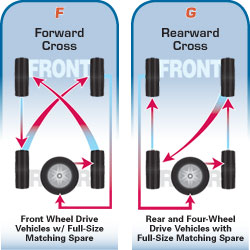
Forward and rearward cross search I have tried to find out why and maybe where the original suggestion came from. I think it has just become conventional wisdom.
Tire Rack is one of several sites that has the same terms and advice. http://www.tirerack.com/tires/tiretech/techpage.jsp?techid=43 Their 5-wheel rotation picture is shown here, but the same patterns without the spare are in that site.
It is not clear to me why one pattern is considered better for FWD and the other is better for RWD and 4WD. I don't think it is a big deal which way you do it, but I sure wonder about the underlying thinking. Any theories?

